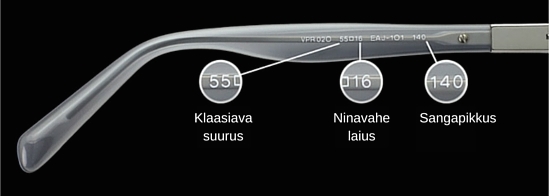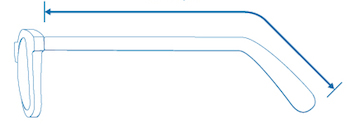How to choose eyeglasses on-line
[accordion]
The best way to find yourself a comfortable and fitting pair of eyeglasses, is to try them on at an optical store. But you might prefer to select your new eyeglasses in the comfort of your home.
Here are a few pointers that can help you find the best eyeglasses from our e-store.
Frame size
Good fit is the key to a successful pair of eyeglasses. If you have worn eyeglasses before, it is easy to determine the sizes of your new eyeglasses simply by checking the size of your current pair.
Eyeglasses have three important measurements:
- Eye size (40...62)
- Bridge size 14...24)
- Temple length (120..150)
The three measurements are usually written in this way: 53-14 145.

The most important measures are the eye size and the bridge size.
The eye size and the bridge size are usually marked side by side and are separated from each other by a dash or a square sign. They can be marked on a temple or on the inside of the bridge. In case of plastic frames, they can also be marked on the inside of the plastic nose pad (in which case they are uncomfortable to find).
Temples
Temple length mostly suitable for women ise 135-140, for men 140-145. Children's eyewear typically has temple lengths of 120-130.
Temples are adjusted for each customer. For adjustments please turn to your optician. Bending temples at home is not allowed.

Model number of eyeglasses
On the temples you can also find the model number. It usually contains a logo, 3-4 digit code and colorcode, e.g Kenzo 2234 C03, or it is a combination of capital letters and numbers, e.g VGV4925 0568. In search of frame size you may ignore this information. Usually the eye size and bridge size information is written right after the model number.
Check the suitable size for your new eyeglasses from your current pair or measure the sizes yourself.
To determine your eyewear size it is best to check your current eyeglasses.
After determining the current sizes, you may then look for frames with similar measurements. They do not need to be identical, you can choose +/-2mm bigger or smaller frames. Please remember that choosing a smaller eye size affects the overall size of your new eyeglasses more than a smaller bridge size because it affects the size of both lenses. In case of plastic eyewear, try to be as exact as possible since it can not be adjusted later. In case of metal frames, the nosepads are ajdustable later to make the frame more comfortable.
In addition to eye size and bridge size add 4-6 mm for the end pieces of the frame. So, if your current eyeglasses are measured 134 mm wide along the curve of the frontal part, then consider that 2 x eyesize + bridge size should add up to 128...130 mm. This way you have also considered the width of the end pieces.
What to do if the old measurements have worn away from the temples
It is common that due to frequent use the markings on the insides of the temples wear off. But you can take the approximate measures from your current pair yourself.
-
Eye size:
Measure with a millimeter ruler the width of the lens at the widest place of the lens, horizontally.
-
Bridge size:
Measure with a millimeter ruler the distance between the lenses at the at the closest point.
-
Temple length
The temple length has to be measured from the tip to the hinge. In case of an unbendable millimeter ruler, measure the length of temple tip and then add the length from the hinge to the bending point.

How to determine the size of eyeglasses if you are looking for your first pair?
It is much more simple to give advice on how to buy fitting clothing than eyewear if the wearer does not have previous experience. Size in eyeglasses is a different concept than size in clothing. All of the following components play a role in selecting a good-fitting pair of glasses: bridge size, eye size, design and shape of the frame, the width of the end piece, whether the frame has spring hinges or not etc. The main thing is: there is no one right size of glasses for any wearer. Your face can accommodate a wide variety of glasses sizes and the only thing that matters in the end, is how they look on you and are they comfortable to wear.
Here are a few pointers that can help you determine the overall eye size suitable for you. Usually lens sizes under 50 mm are for children or for grown-ups with a narrow face. Eye sizes 50-54 are the average lens widths that suit most grownups. Eye size over 55 is considered for a wider face.
|
Size |
Eye size for eyeglasses |
Eye size for sunglasses |
|
Narrow frame |
< 50 mm |
< 55 mm |
|
Average size |
50 – 54 mm |
56-64 mm |
|
Wide frame |
> 55 mm |
> 65 mm |
Where to find the frame measurements in Norman-Optika e-store?
The sizes of eyewear are marked after the code of the frame.
For example:
Royal Muse 2007 black 50-18 140
-
50 – eye size
-
18 – bridge size
-
140 – temple length
In some rare cases the measurements might be missing from our homepage. In this case, please contact the store where this frame is at.
The most common temple sizes are 135 and 140.
The size of sunglasses
The sizes of sunglasses tend to be bigger than that of prescription eyeglasses. It results from the fact that they are much more curved and the eye size is measured along the curve of the frontal part. Hence the measurements are wider. They are also larger in lens size to offer better coverage from sunlight.
Lens selection
From Norman-Optika e-store you can order single vision lenses. In single-vision lenses, there is only one strength, which is designed for viewing distant or near objects or the computer screen.
If you need to order transitions lenses or any other single vision lens type, please contact us by e-mail: info@normanoptika.ee, send the copy of your prescription and link of the frame you want to order. With this data we will send you the invoice.
Progressive and bifocal lenses are advisable to order at our optical stores.
You can see the price list of spectacle lenses here.
On our e-store you may automatically select from the following lenses:
- Index 1.56 20% thinner than lenses of the refractive index of 1.5. Suitable for all frame types except rimless glasses. Very well suited for strengths of up to +/- 2.5
- Index 1.6 30% thinner than a plastic lens with the index of 1.5. Suitable for all types of frames, including rimless spectacles. Recommended from strengths +2.5/- 3.0.
- Index 1.67 40% thinner than a plastic lens of the index of 1.5. Up to 6 times higher impact resistance. Suitable for all types of frames, including rimless spectacles. Recommended from strengths +3.0/- 4.0.
[/accordion]
